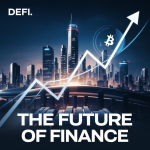
title

Decentralized Finance (DeFi): The Future of Money?
Hey there, crypto enthusiasts! Today, we’re tackling a huge topic: **Decentralized Finance (DeFi)**. You’ve probably heard about it, but what exactly is DeFi? Why does it matter, and how can it revolutionize the way we handle money? Stick around because we’re diving deep into DeFi and its potential to reshape the financial landscape.
What is Decentralized Finance (DeFi)?
In simple terms, **DeFi** refers to a **blockchain-based financial system** that eliminates the need for traditional intermediaries like banks and financial institutions. Instead, it allows people to conduct financial transactions directly with each other using cryptocurrencies. Think of it as a new way to handle money—one that offers greater transparency, security, and accessibility.
DeFi operates on decentralized networks like **Ethereum**, and its open-source nature enables developers to create various financial services such as lending, borrowing, trading, and investing. These services are typically run through **smart contracts**, which are self-executing programs that automatically facilitate transactions when specific conditions are met.
Why is DeFi Important?
Traditional finance, or **centralized finance (CeFi)**, has long been dominated by intermediaries such as banks, payment processors, and brokers. These institutions play a crucial role in facilitating transactions, but they also introduce several inefficiencies into the system:
1. **Costly fees**: Financial intermediaries often charge high fees for their services, making transactions expensive.
2. **Slow processes**: Transferring funds, especially across borders, can take days.
3. **Lack of transparency**: Many financial services operate behind closed doors, making it hard for users to verify their transactions.
4. **Limited accessibility**: Not everyone has access to banking services, especially in underbanked regions.
**DeFi** aims to address these problems by **removing intermediaries** and allowing users to interact with each other directly. This not only reduces costs but also speeds up transactions and increases transparency. Additionally, DeFi services are accessible to anyone with an internet connection, making financial services more inclusive.
How Does DeFi Work?
To understand how **DeFi** works, it’s essential to grasp the role of **smart contracts**. A smart contract is a self-executing contract with the terms of the agreement directly written into code. When certain conditions are met, the contract automatically executes the transaction without the need for intermediaries. These contracts are deployed on a **blockchain**—typically Ethereum—which ensures that they are immutable and transparent.
For example, if you want to **borrow money** in the DeFi ecosystem, you would deposit your cryptocurrency as collateral into a smart contract. The contract then matches you with a lender, who provides you with the funds. Once the loan is repaid with interest, the contract releases your collateral back to you. Everything is done automatically and securely.
Popular DeFi Applications
The DeFi ecosystem has grown rapidly in recent years, with various applications offering different financial services. Here are some of the most common types of DeFi platforms:
1. Decentralized Exchanges (DEXs)
**Decentralized exchanges** allow users to trade cryptocurrencies without the need for a centralized authority. Instead of relying on a traditional exchange to match buyers and sellers, DEXs use **liquidity pools**, where users deposit their assets to facilitate trades. Some popular DEXs include **Uniswap**, **SushiSwap**, and **PancakeSwap**.
2. Lending and Borrowing Protocols
In traditional finance, banks act as intermediaries for lending and borrowing money. In DeFi, users can lend their assets or borrow funds directly from others using platforms like **Aave** and **Compound**. These platforms allow users to earn interest on their deposits while offering borrowers more favorable interest rates.
3. Stablecoins
**Stablecoins** are cryptocurrencies designed to maintain a stable value by being pegged to a fiat currency like the US dollar. Stablecoins like **DAI** and **USDC** are integral to the DeFi ecosystem, as they provide a stable medium of exchange for transactions and protect users from the volatility often associated with cryptocurrencies.
4. Yield Farming and Liquidity Mining
**Yield farming** involves providing liquidity to DeFi protocols in exchange for rewards, often in the form of additional cryptocurrency tokens. **Liquidity mining** is a specific form of yield farming where users are rewarded for providing liquidity to decentralized exchanges. These activities can generate significant returns for participants but also come with risks, such as **impermanent loss**.
5. Derivatives and Synthetic Assets
**Derivatives** in DeFi allow users to create financial products based on the value of other assets, such as stocks, commodities, or even other cryptocurrencies. Platforms like **Synthetix** allow users to create and trade **synthetic assets**, enabling them to gain exposure to assets without actually owning them.
6. Non-Custodial Wallets
A **non-custodial wallet** is a type of cryptocurrency wallet where the user has full control over their private keys. This contrasts with custodial wallets, where a third party holds the private keys on behalf of the user. Non-custodial wallets like **MetaMask** and **Trust Wallet** are essential for interacting with DeFi applications, as they allow users to manage their assets directly.
The Benefits of DeFi
1. **Financial Inclusion**
One of the most significant benefits of DeFi is its potential to provide financial services to those who are underbanked or unbanked. By removing the need for traditional banks, DeFi opens the door for people in remote or economically disadvantaged regions to access loans, investments, and other financial products.
2. **Lower Costs**
By eliminating intermediaries, DeFi reduces the costs associated with financial transactions. For example, sending money across borders can be expensive through traditional means due to high fees, but with DeFi, the costs are much lower.
3. **Transparency**
All transactions on DeFi platforms are recorded on the blockchain, making them transparent and easily verifiable. This level of transparency ensures that all parties involved in a transaction can trust the process.
4. **Security**
DeFi applications leverage the security of blockchain technology, which is virtually immune to hacking or tampering. This provides users with peace of mind when conducting financial transactions.
5. **Greater Control**
In DeFi, users have full control over their assets. Unlike traditional banks, where funds can be frozen or seized, DeFi users maintain ownership of their cryptocurrencies at all times.
The Risks of DeFi
Despite its many advantages, **DeFi** is not without risks. Some of the most common risks include:
1. **Smart Contract Vulnerabilities**
While smart contracts are designed to be secure, they are still code, and code can have bugs. If a smart contract is flawed, it could lead to the loss of funds.
2. **Regulatory Uncertainty**
DeFi operates in a relatively new and unregulated space, which means that the legal framework surrounding these platforms is still evolving. This uncertainty can create risks for both users and developers.
3. **Market Volatility**
Cryptocurrencies are notoriously volatile, and this volatility can impact the value of assets held within DeFi protocols. This makes it essential for users to manage their risk carefully.
How DeFi is Changing the Financial Landscape
DeFi has the potential to **disrupt traditional finance** in several ways. By creating an open, transparent, and accessible financial system, DeFi can:
– **Empower individuals** by giving them greater control over their finances.
– **Promote financial inclusion** by providing services to people who have been excluded from traditional banking.
– **Reduce costs** by cutting out intermediaries and automating processes through smart contracts.
– **Increase efficiency** by speeding up transactions and making them more transparent.
Conclusion
**Decentralized Finance (DeFi)** represents a paradigm shift in the way we handle money. By eliminating intermediaries and leveraging the power of blockchain technology, DeFi offers a more transparent, accessible, and secure financial system. However, like any new technology, it comes with its risks and challenges. As DeFi continues to evolve, it’s crucial to stay informed and navigate this exciting new landscape with care.
Stay tuned for the next articles in this series as we explore more aspects of DeFi. Don’t forget to like, subscribe, and hit the bell to stay updated on our latest content!
Ready to join the Musk Empire? Believe in the project? 🤔 Join now







 Bengali
Bengali Chinese (Simplified)
Chinese (Simplified) English
English Hindi
Hindi Indonesian
Indonesian Irish
Irish Spanish
Spanish Swedish
Swedish Turkish
Turkish